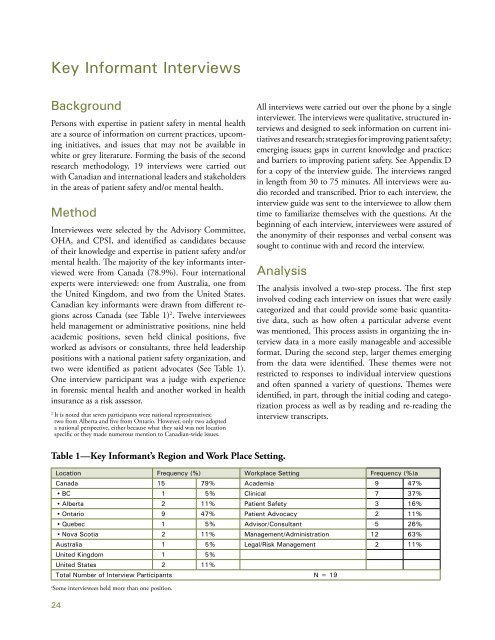Patient safety in mental health - Canadian Patient Safety Institute ...
Patient safety in mental health - Canadian Patient Safety Institute ...
Patient safety in mental health - Canadian Patient Safety Institute ...
Create successful ePaper yourself
Turn your PDF publications into a flip-book with our unique Google optimized e-Paper software.
Key Informant Interviews<br />
Background<br />
Persons with expertise <strong>in</strong> patient <strong>safety</strong> <strong>in</strong> <strong>mental</strong> <strong>health</strong><br />
are a source of <strong>in</strong>formation on current practices, upcom<strong>in</strong>g<br />
<strong>in</strong>itiatives, and issues that may not be available <strong>in</strong><br />
white or grey literature. Form<strong>in</strong>g the basis of the second<br />
research methodology, 19 <strong>in</strong>terviews were carried out<br />
with <strong>Canadian</strong> and <strong>in</strong>ternational leaders and stakeholders<br />
<strong>in</strong> the areas of patient <strong>safety</strong> and/or <strong>mental</strong> <strong>health</strong>.<br />
Method<br />
Interviewees were selected by the Advisory Committee,<br />
OHA, and CPSI, and identified as candidates because<br />
of their knowledge and expertise <strong>in</strong> patient <strong>safety</strong> and/or<br />
<strong>mental</strong> <strong>health</strong>. The majority of the key <strong>in</strong>formants <strong>in</strong>terviewed<br />
were from Canada (78.9%). Four <strong>in</strong>ternational<br />
experts were <strong>in</strong>terviewed: one from Australia, one from<br />
the United K<strong>in</strong>gdom, and two from the United States.<br />
<strong>Canadian</strong> key <strong>in</strong>formants were drawn from different regions<br />
across Canada (see Table 1) 2 . Twelve <strong>in</strong>terviewees<br />
held management or adm<strong>in</strong>istrative positions, n<strong>in</strong>e held<br />
academic positions, seven held cl<strong>in</strong>ical positions, five<br />
worked as advisors or consultants, three held leadership<br />
positions with a national patient <strong>safety</strong> organization, and<br />
two were identified as patient advocates (See Table 1).<br />
One <strong>in</strong>terview participant was a judge with experience<br />
<strong>in</strong> forensic <strong>mental</strong> <strong>health</strong> and another worked <strong>in</strong> <strong>health</strong><br />
<strong>in</strong>surance as a risk assessor.<br />
2 It is noted that seven participants were national representatives;<br />
two from Alberta and five from Ontario. However, only two adopted<br />
a national perspective, either because what they said was not location<br />
specific or they made numerous mention to <strong>Canadian</strong>-wide issues.<br />
2<br />
All <strong>in</strong>terviews were carried out over the phone by a s<strong>in</strong>gle<br />
<strong>in</strong>terviewer. The <strong>in</strong>terviews were qualitative, structured <strong>in</strong>terviews<br />
and designed to seek <strong>in</strong>formation on current <strong>in</strong>itiatives<br />
and research; strategies for improv<strong>in</strong>g patient <strong>safety</strong>;<br />
emerg<strong>in</strong>g issues; gaps <strong>in</strong> current knowledge and practice;<br />
and barriers to improv<strong>in</strong>g patient <strong>safety</strong>. See Appendix D<br />
for a copy of the <strong>in</strong>terview guide. The <strong>in</strong>terviews ranged<br />
<strong>in</strong> length from 30 to 75 m<strong>in</strong>utes. All <strong>in</strong>terviews were audio<br />
recorded and transcribed. Prior to each <strong>in</strong>terview, the<br />
<strong>in</strong>terview guide was sent to the <strong>in</strong>terviewee to allow them<br />
time to familiarize themselves with the questions. At the<br />
beg<strong>in</strong>n<strong>in</strong>g of each <strong>in</strong>terview, <strong>in</strong>terviewees were assured of<br />
the anonymity of their responses and verbal consent was<br />
sought to cont<strong>in</strong>ue with and record the <strong>in</strong>terview.<br />
Analysis<br />
Table 1—Key Informant’s Region and Work Place Sett<strong>in</strong>g.<br />
The analysis <strong>in</strong>volved a two-step process. The first step<br />
<strong>in</strong>volved cod<strong>in</strong>g each <strong>in</strong>terview on issues that were easily<br />
categorized and that could provide some basic quantitative<br />
data, such as how often a particular adverse event<br />
was mentioned. This process assists <strong>in</strong> organiz<strong>in</strong>g the <strong>in</strong>terview<br />
data <strong>in</strong> a more easily manageable and accessible<br />
format. Dur<strong>in</strong>g the second step, larger themes emerg<strong>in</strong>g<br />
from the data were identified. These themes were not<br />
restricted to responses to <strong>in</strong>dividual <strong>in</strong>terview questions<br />
and often spanned a variety of questions. Themes were<br />
identified, <strong>in</strong> part, through the <strong>in</strong>itial cod<strong>in</strong>g and categorization<br />
process as well as by read<strong>in</strong>g and re-read<strong>in</strong>g the<br />
<strong>in</strong>terview transcripts.<br />
Location Frequency (%) Workplace Sett<strong>in</strong>g Frequency (%)a<br />
Canada 1 % Academia %<br />
• BC 1 % Cl<strong>in</strong>ical 3 %<br />
• Alberta 2 11% <strong>Patient</strong> <strong>Safety</strong> 3 1 %<br />
• Ontario % <strong>Patient</strong> Advocacy 2 11%<br />
• Quebec 1 % Advisor/Consultant 2 %<br />
• Nova Scotia 2 11% Management/Adm<strong>in</strong>istration 12 3%<br />
Australia 1 % Legal/Risk Management 2 11%<br />
United K<strong>in</strong>gdom 1 %<br />
United States 2 11%<br />
Total Number of Interview Participants N = 1<br />
a Some <strong>in</strong>terviewees held more than one position.


